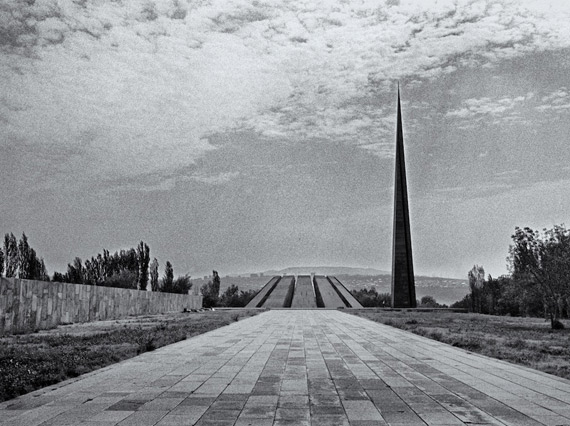At the origins of commemoration: April 24 as a day of mourning and commemoration of the Armenian Genocide

Նմանատիպ
By the Official web-site of the Armenian Genocide Museum-Institute
In March 1919 a special committee was formed in Constantinople by a group of Ottoman Armenian intellectuals, who had survived the Armenian Genocide. The main goal of this committee was the organization of commemoration ceremonies dedicated to the 4th anniversary of the Armenian Genocide. The committee, known as “The April 11th Board for Mourning Ceremony” consisted of 13 members including Yevphime Avetisian, Zaruhi Galamkyarian, Mary Stambulian, Perchuhi Parsamian, Miss Arpiar, Tigran Zaven, Merujan Parsamian, Hakob Siruni, Gevorg Mesrop, Tagvor Sukiasian, Dr. Barsegh Tinanian, Shahan Perperian and Hovhannes Poghosian. Due to the efforts of these people the commemoration honouring the memory of the victims of the Armenian Genocide was held among the Armenians of Constantinople for the first time in 1919. Armenian writer, publicist and public figure Hakob Siruni wrote the following in his memoirs: “The mourning ceremony became a tradition. Since then, the 24th of April became a day of mourning for Armenians.”
According to the committee, commemoration ceremonies were to be held on April 11/24, but obviously because of the Armenian Patriarch’s illness the commemoration was delayed by a day. Bishop Mesrop Naroian spoke a liturgy for the victims of the Armenian Genocide on April 12/25 in St. Trinity Church of Bera district of Constantinople. Zaven Yeghiaian, the Armenian Patriarch of Constantinople, gave a sermon stating that “all martyrs are grains of wheat, covered by earth, one day they will sprout and give fruits.” On this declared “day of mourning,” all Armenian national colleges and shops in Constantinople were closed. Besides Western Armenians, representatives of Saint Trinity Greek Church, RA representative P. Takhtadgian and others were present during the ceremony.
Western Armenian journalist Hakob Ter-Hakobyan, referring to the implication of the day, particularly mentioned the following: “Today when our hearts are full of mourning for those precious Armenians who had been lost forever, when we once again shed a tear for our beloved compatriots during this simple mourning ceremony, we become ever closer to them through these four years of solitude and we great and hug them by such an inexplicable embraces and passionate outpourings we have never had before.”
In the afternoon, the attendants gathered in the church moved to to the St. Trinity Armenian Evangelical Church located in the Cheshme district of the city. After the liturgy, the ceremonial mourning took place, accompanied with speeches, recitals and sacred music. An opening speech on behalf of Board for Mourning Ceremony was delivered by Shahan Perperian, which was followed by speeches of Vahan Zeituntsian and Professor H. Hakobian, representatives of Hunchak and Democratic Liberal parties, Dr. Khanjian from the Doctor’s Union, Gevorg Mesrop from the Teacher’s Union and many others. The speeches were accompannied with recitals and tragical music. A volume entitled “Memorial for April 11th”, edited by Teodik, was published in Constantinople (O. Arzuman Publishing, 1919) “in memory of intelligentsia martyred in Constantinople and provinces.” The biographies, photos and unpublished materials of these intellectuals were also included in the book.
The initial commemoration for the victims of the Armenian Genocide in Constantinople was not the only one of its kind. On April 24, 1919 another liturgy was said in the St. Trinity Church in Bera by Armenian Patriarch in memory of American missionaries martyred during WWI. Mr. Heike and Mr. Faull, representatives of the US Embassy to Turkey, a journalist from the “Times”, Colonel Bennett and others participated in the ceremony.
The next day, on April 25th, a similar ceremony dedicated to the martyrs of the Armenian Genocide took place in the Armenian Catholic Church of Vatican under the approval of Pope. The entire Armenian community in Italy was present along with several cardinals and bishops (as representatives of the Pope), members of the Italian Government, Minister of Education M. Ludzatti, President of Parliament Lombardo, Deputy Foreign Minister, French ambassador to Italy and other officials.
The decision of declaring April 24 as a Day of Mourning and Remembrance was made only two years later. In 1921 Catholicos of All Armenians issued a special epistle addressed to Armenian Patriarch of Constantinople calling to declaring April 11/24 as a national mourning day (“in memory of several Armenian martyrs, who fell victim during WWI”). He also stated that the day was introduced in the Ejmiatsin calendar as a mourning day and should be introduced in the calendar of Armenian Patriarchate as well. On April 23 all editorial houses were informed by circulars about the following: “It would be better to declare a single day both as a day of mourning and in memory of martyrs who fell during War and exhile. By the order of His Holiness that day may be commemorated by all Armenians.” The same year on April 24 (on Palm Sunday) a requiem liturgy was said in all Armenian churches of Constantinople by the order of Patriarchate on the occasion of “Armenian exile and martyrdom.” The same day after the liturgy special mourning ceremonies were held in theatre halls in Bera and Samatia districts of Constantinople. A number of intellectuals and clergymen (Yeghishe Archibishop Durian, Hrach Yervand, A. Mikayelian, Hovsep Ter Markarian and others), who had survived the Armenian Genocide, delivered reports and speeches. They called the audience to always keep the memory of innocent victims of the Genocide and never give way to despair.
Հետևեք մեզ նաև Telegram-ում